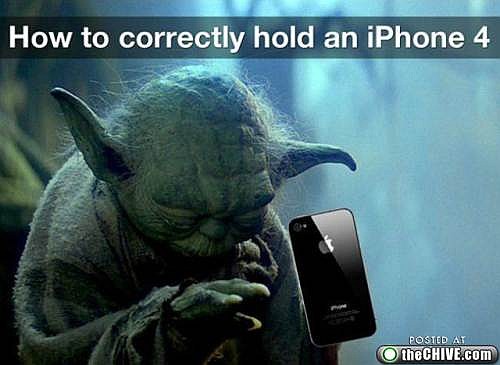
Apple has issued an open letter to explain the reception degradation problem on the iPhone 4. But before they get to that, Apple is quick to point out that “Droid, Nokia and RIM phones” exhibit the same tendency to drop signals in a very much the same way the iPhone 3GS and iPhone 4 does.
From Apple’s point of view, the cause of the dramatic drop in signal performance is “both simple and surprising.” Apple claims that right now the software that determines how many signal bars are displayed on the iPhone is indicating an overly optimistic figure.
Essentially when the iPhone is showing 5 bars you are realistically getting only 2 or 3 bars. As a result, Apple will be releasing an update to fix this over-reading issue so that all iPhones will display a more accurate signal reception reading. On top of that, Apple will also make signal bars 1, 2 and 3 taller so that it is easier to see.
In the letter Apple says that the over-reading problem “…has been present since the original iPhone…” and the software fix will be available for all iPhones. At the same time Apple is accepting returns of undamaged iPhone 4 for a full refund if returned in 30 days from purchase.
Here’s the thing, the software update doesn’t fix the attenuation problem, it just tells your iPhone to give you a better reading of the reception that it is getting. Also, Apple say that the software will make bars 1,2 and 3 taller, why are they explicitly telling us this? Usually in such upgrades, Apple have been known to just forgo telling its users such mundane a details, so why tell us now?
Besides, what does making signal bars taller have to do with solving the problem at hand? If anything, it will just create the illusion that you’re getting better reception, because the bars are taller now.
Fact of the matter is, the iPhone 4 antenna design is flawed and Apple knows it. It looks to us like Apple is doing everything they can to make it look like a non-issue.
You might want to read the full letter before going out to pre-order you iPhone 4, which we think won’t be long now for us Malaysians.
Letter from Apple Regarding iPhone 4
Dear iPhone 4 Users,
The iPhone 4 has been the most successful product launch in Apple’s history. It has been judged by reviewers around the world to be the best smartphone ever, and users have told us that they love it. So we were surprised when we read reports of reception problems, and we immediately began investigating them. Here is what we have learned.
To start with, gripping almost any mobile phone in certain ways will reduce its reception by 1 or more bars. This is true of iPhone 4, iPhone 3GS, as well as many Droid, Nokia and RIM phones. But some users have reported that iPhone 4 can drop 4 or 5 bars when tightly held in a way which covers the black strip in the lower left corner of the metal band. This is a far bigger drop than normal, and as a result some have accused the iPhone 4 of having a faulty antenna design.
At the same time, we continue to read articles and receive hundreds of emails from users saying that iPhone 4 reception is better than the iPhone 3GS. They are delighted. This matches our own experience and testing. What can explain all of this?
We have discovered the cause of this dramatic drop in bars, and it is both simple and surprising.
Upon investigation, we were stunned to find that the formula we use to calculate how many bars of signal strength to display is totally wrong. Our formula, in many instances, mistakenly displays 2 more bars than it should for a given signal strength. For example, we sometimes display 4 bars when we should be displaying as few as 2 bars. Users observing a drop of several bars when they grip their iPhone in a certain way are most likely in an area with very weak signal strength, but they don’t know it because we are erroneously displaying 4 or 5 bars. Their big drop in bars is because their high bars were never real in the first place.
To fix this, we are adopting AT&T’s recently recommended formula for calculating how many bars to display for a given signal strength. The real signal strength remains the same, but the iPhone’s bars will report it far more accurately, providing users a much better indication of the reception they will get in a given area. We are also making bars 1, 2 and 3 a bit taller so they will be easier to see.
We will issue a free software update within a few weeks that incorporates the corrected formula. Since this mistake has been present since the original iPhone, this software update will also be available for the iPhone 3GS and iPhone 3G.
We have gone back to our labs and retested everything, and the results are the same— the iPhone 4’s wireless performance is the best we have ever shipped. For the vast majority of users who have not been troubled by this issue, this software update will only make your bars more accurate. For those who have had concerns, we apologize for any anxiety we may have caused.
As a reminder, if you are not fully satisfied, you can return your undamaged iPhone to any Apple Retail Store or the online Apple Store within 30 days of purchase for a full refund.
We hope you love the iPhone 4 as much as we do.
Thank you for your patience and support.
[source]
[picture credit]






